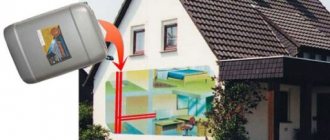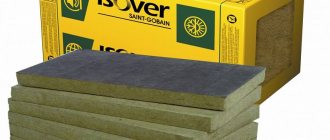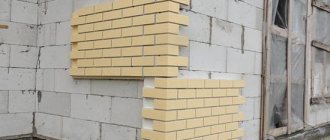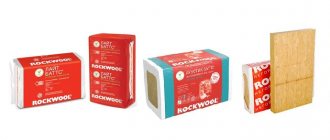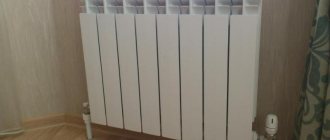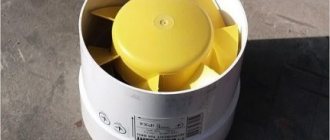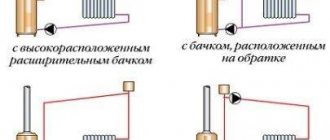Technology of wall insulation with straw
The construction of a house from straw bales, which is also its insulation, involves the following stages of work:
- Preparing insulation. Bundles of straw are soaked in a solution of 10% copper sulfate and, after impregnation, are set aside until completely dry.
- Installation of the sheathing to which the straw blocks are attached.
- Installation of blocks to the sheathing using special rods.
- Plastering walls made of straw blocks with a cement-clay mixture.
- A final decorative finish that also increases the fire resistance of thatched walls.
Insulating a frame house with straw
Frame houses can be insulated with pressed straw blocks and light adobe.
The blocks are placed between the frame posts and fixed in the center using vertical rods made of metal or wood. The material is inexpensive, practically does not shrink, and installation takes a matter of days.
Light adobe technology involves the construction of walls from a mixture of clay and straw and takes a lot of time. The principle is based on compacting straw soaked in liquid clay into a sliding formwork.
Coating the house with clay
A “muzanka” or a house that is coated with clay is a very comfortable and environmentally friendly housing. In the summer it is quite cool, and in the cold it is warm, while the organized microclimate has a beneficial effect on human health. Coating a house with clay is a somewhat labor-intensive job; for this reason, it has recently lost some of its popularity, giving way to simpler types of work. If you are not afraid of difficulties, and you are fully ready to revive the old method, try building a “mud” on your own.
Well, if you are interested in planning and creating interiors of public buildings, visit the website studio-practica.ru. Only there they will help you create a suitable and comfortable interior quickly and without problems.
Build the frame and foundation of the mud hut house. You can just drive stakes into the ground and carefully intertwine them with twigs; this will be a fairly simple structure for storing things and relaxing in the summer. To build a more substantial housing, you should build a concrete foundation - install vertical beams on it, fill the beams with them, and cover the structure with a board or slab.
The surface of all walls should be covered with willow rod or shingles to ensure excellent adhesion of the wall to the clay. The rods should be stuffed at an angle of 45°, while using an ax to split thick branches into 2 halves. If possible, immediately build a roof for the structure.
Then start preparing the clay. To do this, take a container; it is recommended to dig a large round hole in the ground. Place sand and clay in the hole in layers, pour water into the center.
Mix the clay - it is recommended to do this using your feet. If the container is small, use a drill with a regular curved pin or a special attachment. Gradually add straw to the clay - the thicker the stem, the better.
Knead the clay, moving towards the edge starting from the center. If necessary, add straw or water. You should not throw a large amount of straw at once, otherwise it will not be easy to mix. Clay should be thrown from the edges into the center of the hole. As a result of the above steps, you will get a fairly thick, homogeneous mass.
The wooden surface of the wall must be slightly moistened with water using a broom. Bring the clay closer to the building, you can load it into the cart. It is recommended to work with clay using a fork rather than a shovel.
Take the clay mat with your hands and throw it forcefully at the wall. The clay should stick well and turn into a pancake. When covering shingles or rods, spread them a little.
If the clay does not stay on the wall overnight, you should tear it off and let the surface of the wall dry. Sometimes you need to wet your hands with water.
Photo: avillageinafrica.wordpress.com
Choosing straw for the ceiling
Straw with clay as insulation for ceilings has the following quality requirements:
- Thermal insulation of ceilings should be carried out only with straw that has been well dried in a special chamber.
- Straw bales should be easy to lift with one hand, strong and maintain their shape. Bundles of the same size should have the same weight. The difference in weight may indicate the presence of moisture in the bundle.
- Metal wire is susceptible to corrosion, so tying should be done with a nylon cord.
Advantages and disadvantages of insulating ceilings with straw
Insulating ceilings with straw has its positive and negative sides, after weighing them, you can decide whether to choose this method.
Advantages:
- excellent thermal insulation properties, several times higher than those of wood;
- environmentally friendly and breathable material;
- the material can be easily disposed of by burning;
- lightness of the material and its installation process.
The disadvantages of straw insulation for ceilings include the ability to ignite poorly compacted material and the likelihood of damage by rodents. The quality of the material is directly dependent on the conditions of collection of raw materials, their storage and drying method.
Instructions for installing straw on the ceiling
You can insulate the ceiling with compressed straw blocks and light adobe.
The first method involves laying blocks tightly pressed against each other or staggered, which are covered on top with a waterproofing film and then with the finishing floor covering.
Ceiling insulation with light adobe looks like this:
- The attic is covered with a vapor barrier film, onto which a solution of clay and straw 5 cm thick is applied.
- A dry straw layer 10-15 cm thick is laid on the dried base.
- A protective layer of clay mortar 2 cm thick is applied.
- The wooden flooring is installed along the joists.
Insulating a country house with straw: advantages and disadvantages
Today, the use of environmentally friendly and energy-efficient materials is becoming increasingly popular. The new generation of conscious consumption seeks to minimize environmental damage as much as possible. It was the adherents of an environmentally friendly lifestyle who began to actively use eco-materials in construction and began to build houses from straw. Will such a house be durable and what is the ratio of advantages and disadvantages when building a house from straw? We will talk about this in this article.
Trend for environmentally friendly modern materials
Advantages and disadvantages of using straw insulation
The process of production and subsequent operation of straw insulation
What stops customers from using straw insulation?
Article on the topic: Swimming pool in a suburban area: advantages and disadvantages. Expert opinion
Trend for environmentally friendly modern materials
Straw, as a material for construction, is used in many countries around the world. Surprisingly, we are not talking only about individual low-rise construction. For example, in Germany, two- and three-story hotels are built using straw insulation. In addition, straw technology is used in many areas of Eurasia and North America.
Advantages and disadvantages of using straw insulation
Video on the topic: Scandinavian frame framing according to the rules. How much does USHP cost?
Speaking about straw insulation, first of all I would like to note the fact that its creation does not require cutting down trees, and its further decomposition does not harm the environment.
Of all the possible options for environmentally friendly insulation, straw is the only one that does not require separate production. The raw materials simply remain in the fields after the cereal harvest. In addition, straw is not only much lighter than wood, but also retains heat in the house four times better. Due to its porous structure, it does not conduct thermal energy: in order to obtain the same thermal insulation using brick, you will have to build a wall ten times thicker than a straw one. Straw has no nutrients and is therefore unattractive to rodents.
Article on the topic: Registration of ancillary buildings on the site of a country house
A straw house is built quite quickly. It retains heat well and at the same time is easy to breathe - thick walls maintain a comfortable temperature for a person. Thanks to vapor-permeable plaster, excess moisture is removed from the house, and the straw inside the wall remains dry.
The process of production and subsequent operation of straw insulation
Related article: How to install a wet plaster facade in a country house
The production process of wooden panels with straw insulation consists of several stages. It starts with gluing together wooden panels. Only dried and polished boards are used - this is the only way to avoid subsequent deformation. Gluing is done using a vima (a special gluing press) of our own design. Next comes the assembly of the wooden frame for the panel. Thanks to the reinforced structure, each panel can serve as a load-bearing wall. The next step is to press the straw into the panel. This is done using a hydraulic press. At the final stage, the front sides of the panels are covered with a layer of pouring plaster.
Panels for the construction of a one-story house with an area of 28 square meters. meters fit into two or three gazelles. If there is a foundation, then a ready-to-move-in house can be erected in three to four days with just a crane and a hammer. If there is no foundation, the client is asked to contact a contractor. There are no unique or complex requirements for the foundation for such a house. If desired, such a house can be disassembled at any time, loaded into a car and reassembled in a new place.
What stops customers from using straw insulation?
Despite the advantages of this type of insulation, it is not popular among Russian customers. The reason is the prevailing stereotype that such houses are cold and unreliable. Surely many people immediately remember the fairy tale about the three little pigs, in which one of the brothers built a house out of straw and failed. Straw insulation is also not benefited by widespread rumors about rodents that allegedly live in the material. In addition, many are sure that a thatched house will rot in almost a year. Of course, if waterproofing is done incorrectly, this can actually happen, so it is very important to follow the technology.
Today, many enterprising entrepreneurs are fighting for straw to be included in the list of environmentally friendly building materials. To do this, it needs to obtain certification for compliance with EcoStandardGroup standards.
Protecting straw bale from damage
Using straw compressed into blocks as insulation makes it possible to obtain walls that are resistant to rot, fire, rodents and insects. But these conditions are met only with high-quality pressing of raw materials. For the bundles, dry rye is used, which contains a large amount of silica, so rodents do not eat it. Tightly compressed raw materials do not have access to air, therefore they are not flammable and do not allow mice and rats to gnaw through passages. For additional protection against rodents, metal mesh is installed at the bottom of the walls. Rotting of straw can begin when the humidity in the blocks increases to 20%.
Additionally, plaster will help protect the thatched walls. The traditional option is clay plaster, but for external wall coverings it is recommended to use cement-sand plaster, which is more resistant to moisture. Interior finishing can be done with lime plaster.
Straw: traditional and modern uses
Traditional material
Straw has been used in construction since time immemorial.
Straw is a waste product from agricultural activities.
Most often used:
- rye,
- rice
- and wheat raw materials.
Therefore, in the territories where agricultural civilizations lived, this material is found quite often in traditional buildings:
- hatah;
- churches;
- on the roofs of stone houses and castles;
- hangars and sheds.
This material is widespread in Slavic countries:
- Russia,
- Belarus,
- Ukraine,
- Poland,
- in the Balkans.
This is not surprising, because throughout history the Slavs were engaged in agriculture and grew bread. In addition, there is a huge proportion of steppe and lowland landscapes, where wood is much less common, and it was not possible to transport it from distant forests.
In Russia, straw was used as insulation; it was laid in attics and roofs, but in Ukraine, so-called mud huts were made from it - huts made of clay mixed with straw stems and hay (

